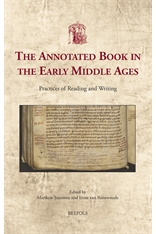The Annotated Book in the Early Middle Ages, ed. Mariken Teeuwen and Irene van Renswoude (Turnhout, 2017: USML 38), xii+783 pp. ISBN 978-2-503-56948-2.
Annotations in modern books are a phenomenon that often causes disapproval: we are not supposed to draw, doodle, underline or highlight in our books. We are brought up with the idea that books are too valuable to do this; future readers will have to use these books, and they are not helped with our annotations or markings. But if we go back in time to the period of the handwritten book, this is completely different.
In many medieval manuscripts, pages are filled with annotations around the text and in between the lines. In some cases, the “white area” around the text is even laid out to contain extra text, pricked and ruled for the purpose. Just as footnotes are an approved and standard part of the modern academic book, so are the flyleaves, margins and interlinear spaces of many medieval manuscripts an invitation to add extra text.
In this volume, we analyze this phenomenon for the early medieval period. We treat the manuscripts as mirrors of the medieval minds who created them, reflecting their interests, their choices, their practices. We ask ourselves whether the phenomenon of annotating manuscripts adheres to certain rules and patterns. For example, are there certain genres in which the making of annotations seems to be more appropriate or common than in others? Are there genres in which annotating is “not done”? Are there certain monastic centres in which annotating practices flourish, and from which they spread? Do the annotators use specific techniques, perhaps specific to their scribal communities or schools? What do they seek to accomplish with their annotations? How do these techniques develop over time, and what are regional differences?
Contents:
Mariken Teeuwen and Irene van Renswoude, “Introduction”
Section I: Scholars and Their Books: Practices and Methods of Annotating
Mariken Teeuwen, “Voices from the Edge: Annotating Books in the Carolingian Period”
Evina Steinová, “Technical Signs in Early Medieval Manuscripts Copied in Irish Minuscle”
Giorgia Vocino, “A peregrinus’s Vade Mecum: ms Bern 363 and the ‘Circle of Sedulius Scottus’”
Warren Pezé, “The Making of the De praedestinatione of Ratramnus of Corbie (Including the Identification of a New Personal Manuscript)”
Giacomo Vignodelli, “The Making of a Tenth-Century Self-Commentary: The Glosses to Atto of Vercelli’s Perpendiculum and Their Sources”
Section II: Textual Scholarship by Means of Annotation
Franck Cinato, “The Earliest Anonymous Exposition of Priscian: Two Manuscripts and Their Glosses”
Markus Schiegg, “Source Marks in Scholia: Evidence from an Early Medieval Gospel Manuscript”
Martin Hellmann, “Tironische Tituli: Die Verwendung stenographischer Marginalien zur inhaltlichen Erschließung von Texten des frühen Mittelalters”
Andreas Nievergelt, “Glossen aus einem einzigen Buchstaben”
Justin Stover, “Space as Paratext: Scribal Practice in the Medieval Edition of Ammianus Marcellinus”
Erik Kwakkel, “The Margin as Editorial Space: Upgrading Dioscorides alphabeticus in Eleventh-Century Monte Cassino”
Alberto Cevolini, “Making notae for Scholarly Retrieval: A Franciscan Case Study”
Section III: Private Study and Classroom Reading
Sinéad O’Sullivan, “Reading and the Lemma in Early Medieval Textual Culture”
Silvia Ottaviano, “Reading between the Lines of Virgil’s Early Medieval Manuscripts”
Anna Grotans, “Notker Labeo’s Translation / Commentaries: Changing Form and Function over Time”
Ad van Els, “Transmitting Knowledge by Text and Illustration: The Case of ms Leiden, ub, vlo 15”
Micol Long, “Monastic Practices of Shared Reading as Means of Learning”
Paulina Taraskin, “Reading Horace alongside Other Classics: ms British Library, Harley 2724”
Section IV: Annotating Orthodox and Heterodox Knowledge
Irene van Renswoude, “The Censor’s Rod: Textual Criticism, Judgment, and Canon Formation in Late Antiquity and the Early Middle Ages”
Luciana Cuppo, “Text and Context: The Annotations in ms Verona, Biblioteca Capitolare XXII (20)”
Janneke Raaijmakers, “Studying Jerome in a Carolingian Monastery”
Pierre Chambert-Protat, “Deux témoins d’Ambroise sur le Psaume 118 et leur ancêtre”
Jesse Keskiaho, “The Annotation of Patristic Texts as Curatorial Activity? The Case of Marginalia to Augustine’s De Genesi ad litteram in Late Antiquity and the Middle Ages”
Cinzia Grifoni, “Reading the Catholic Epistles: Glossing Practices in Early Medieval Wissembourg”
Patrizia Carmassi, “Theological Issues and Traces of Controversies in Manuscripts Transmitting Works of the Church Fathers”
Epilogue
David Ganz, “The Search for Glossed Clauses: An Autobiographical Account of a Corbie Study”


